Think Big: Innovation and Agile Supply Chain in Fashion Retailing
VerifiedAdded on 2021/06/18
|8
|1951
|267
Project
AI Summary
This project, titled "Think Big," examines the need for innovation within the fast-fashion retail industry, which faces challenges in adapting to evolving customer demands and managing complex supply chains. The project proposes the integration of PowerSourcers, a business concept designed to provide real-time information flow among stakeholders, including suppliers, manufacturers, and retailers. This agile supply chain model utilizes technologies like RFID and ERP to enhance merchandise tracking, reduce lead times, and improve customer satisfaction. The project justifies this model's potential to address customer preferences, improve supply chain clarity, and reduce operational costs, ultimately fostering brand loyalty and increased revenue. The integration of PowerSourcers promises to create an innovative environment with effective collaboration among different departments to drive customer engagement and satisfaction.
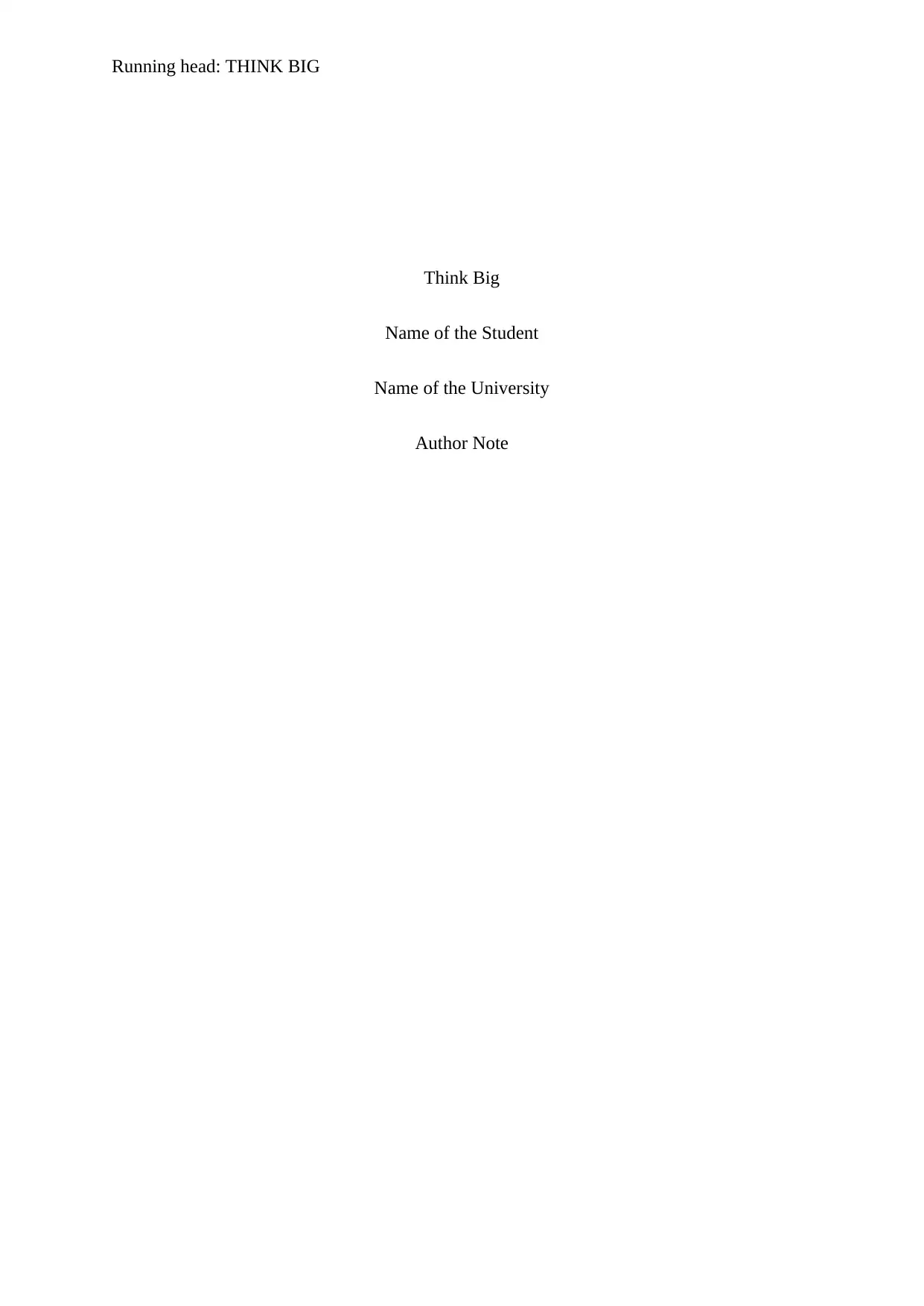
Running head: THINK BIG
Think Big
Name of the Student
Name of the University
Author Note
Think Big
Name of the Student
Name of the University
Author Note
Paraphrase This Document
Need a fresh take? Get an instant paraphrase of this document with our AI Paraphraser
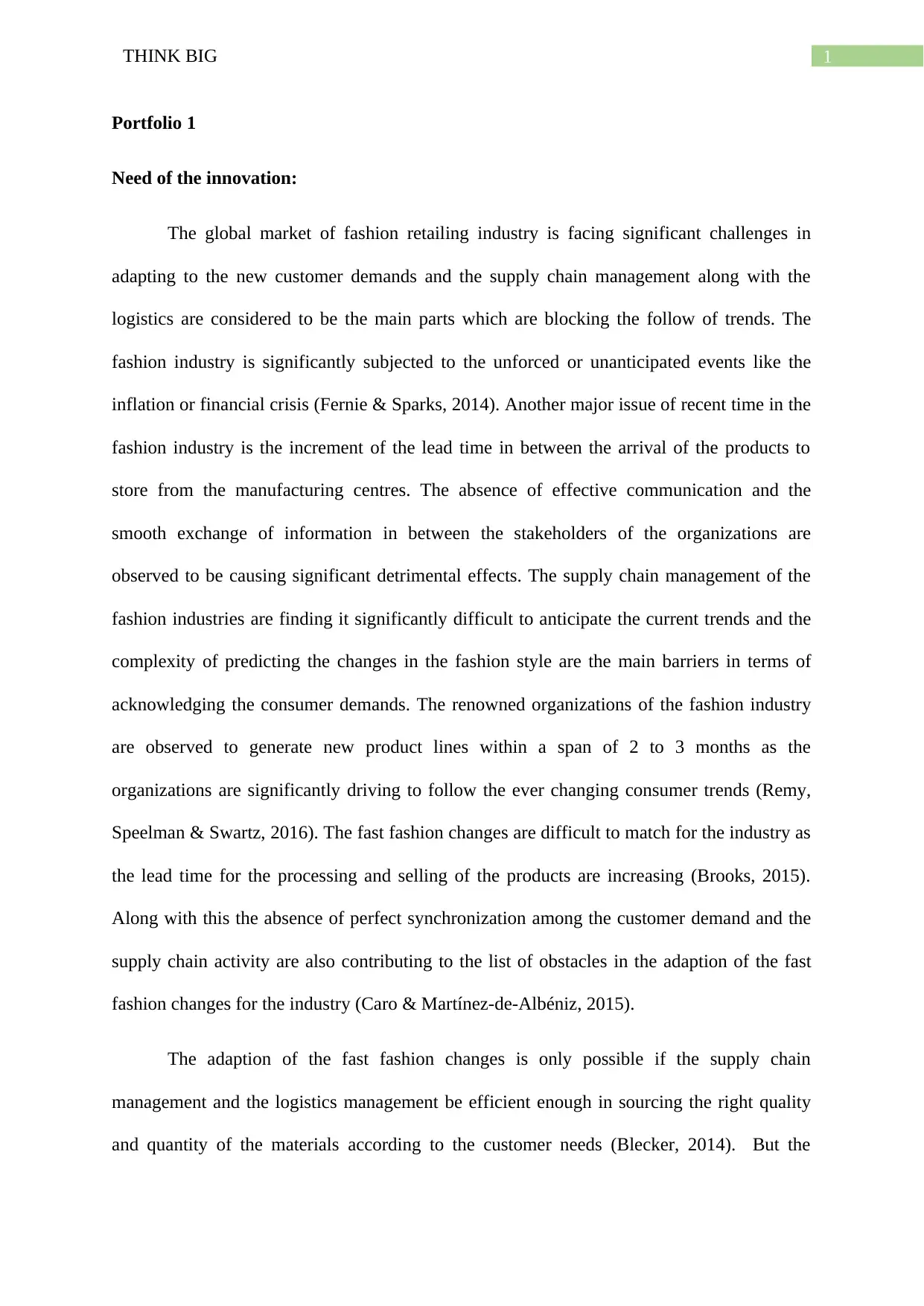
1THINK BIG
Portfolio 1
Need of the innovation:
The global market of fashion retailing industry is facing significant challenges in
adapting to the new customer demands and the supply chain management along with the
logistics are considered to be the main parts which are blocking the follow of trends. The
fashion industry is significantly subjected to the unforced or unanticipated events like the
inflation or financial crisis (Fernie & Sparks, 2014). Another major issue of recent time in the
fashion industry is the increment of the lead time in between the arrival of the products to
store from the manufacturing centres. The absence of effective communication and the
smooth exchange of information in between the stakeholders of the organizations are
observed to be causing significant detrimental effects. The supply chain management of the
fashion industries are finding it significantly difficult to anticipate the current trends and the
complexity of predicting the changes in the fashion style are the main barriers in terms of
acknowledging the consumer demands. The renowned organizations of the fashion industry
are observed to generate new product lines within a span of 2 to 3 months as the
organizations are significantly driving to follow the ever changing consumer trends (Remy,
Speelman & Swartz, 2016). The fast fashion changes are difficult to match for the industry as
the lead time for the processing and selling of the products are increasing (Brooks, 2015).
Along with this the absence of perfect synchronization among the customer demand and the
supply chain activity are also contributing to the list of obstacles in the adaption of the fast
fashion changes for the industry (Caro & Martínez-de-Albéniz, 2015).
The adaption of the fast fashion changes is only possible if the supply chain
management and the logistics management be efficient enough in sourcing the right quality
and quantity of the materials according to the customer needs (Blecker, 2014). But the
Portfolio 1
Need of the innovation:
The global market of fashion retailing industry is facing significant challenges in
adapting to the new customer demands and the supply chain management along with the
logistics are considered to be the main parts which are blocking the follow of trends. The
fashion industry is significantly subjected to the unforced or unanticipated events like the
inflation or financial crisis (Fernie & Sparks, 2014). Another major issue of recent time in the
fashion industry is the increment of the lead time in between the arrival of the products to
store from the manufacturing centres. The absence of effective communication and the
smooth exchange of information in between the stakeholders of the organizations are
observed to be causing significant detrimental effects. The supply chain management of the
fashion industries are finding it significantly difficult to anticipate the current trends and the
complexity of predicting the changes in the fashion style are the main barriers in terms of
acknowledging the consumer demands. The renowned organizations of the fashion industry
are observed to generate new product lines within a span of 2 to 3 months as the
organizations are significantly driving to follow the ever changing consumer trends (Remy,
Speelman & Swartz, 2016). The fast fashion changes are difficult to match for the industry as
the lead time for the processing and selling of the products are increasing (Brooks, 2015).
Along with this the absence of perfect synchronization among the customer demand and the
supply chain activity are also contributing to the list of obstacles in the adaption of the fast
fashion changes for the industry (Caro & Martínez-de-Albéniz, 2015).
The adaption of the fast fashion changes is only possible if the supply chain
management and the logistics management be efficient enough in sourcing the right quality
and quantity of the materials according to the customer needs (Blecker, 2014). But the
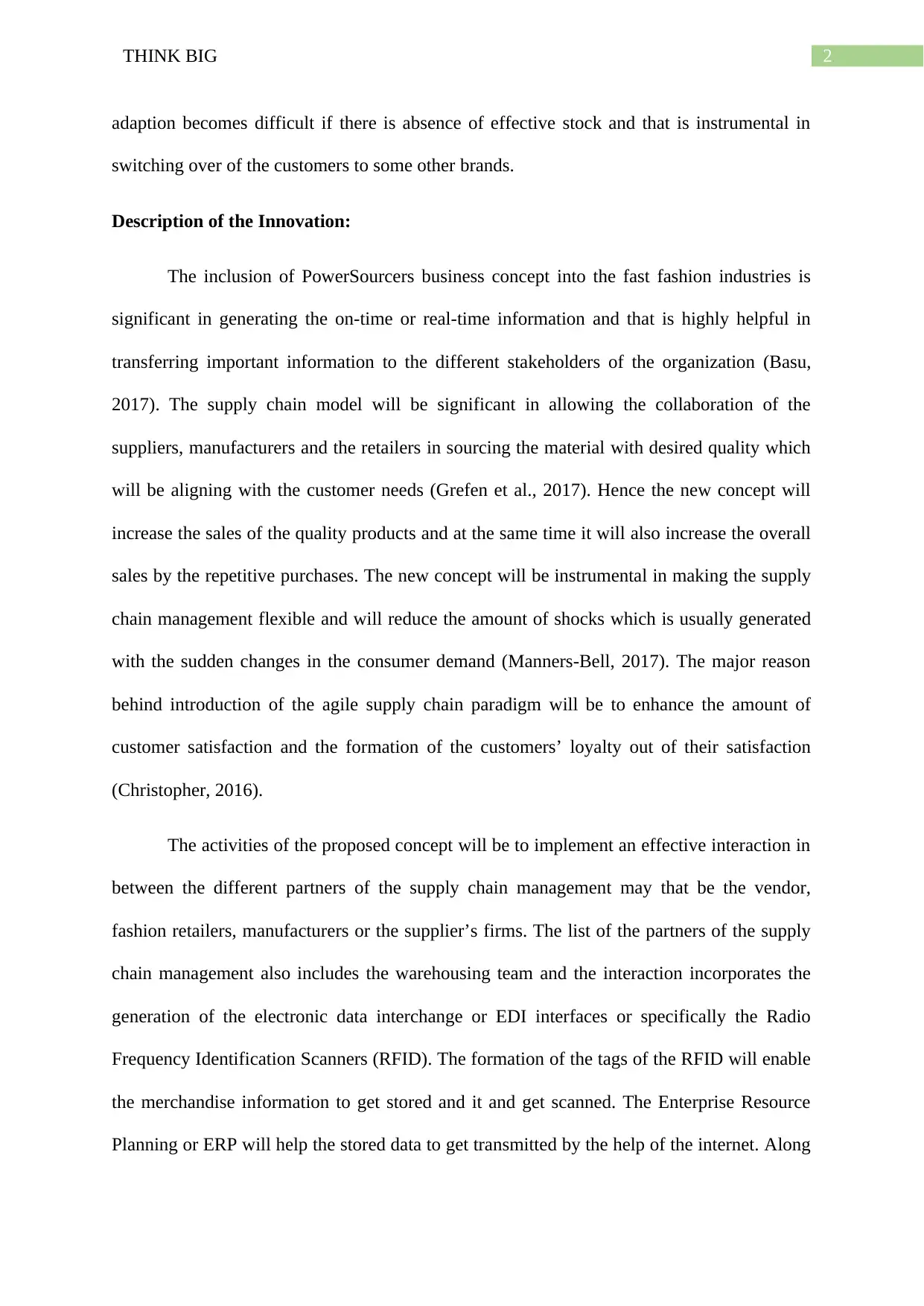
2THINK BIG
adaption becomes difficult if there is absence of effective stock and that is instrumental in
switching over of the customers to some other brands.
Description of the Innovation:
The inclusion of PowerSourcers business concept into the fast fashion industries is
significant in generating the on-time or real-time information and that is highly helpful in
transferring important information to the different stakeholders of the organization (Basu,
2017). The supply chain model will be significant in allowing the collaboration of the
suppliers, manufacturers and the retailers in sourcing the material with desired quality which
will be aligning with the customer needs (Grefen et al., 2017). Hence the new concept will
increase the sales of the quality products and at the same time it will also increase the overall
sales by the repetitive purchases. The new concept will be instrumental in making the supply
chain management flexible and will reduce the amount of shocks which is usually generated
with the sudden changes in the consumer demand (Manners-Bell, 2017). The major reason
behind introduction of the agile supply chain paradigm will be to enhance the amount of
customer satisfaction and the formation of the customers’ loyalty out of their satisfaction
(Christopher, 2016).
The activities of the proposed concept will be to implement an effective interaction in
between the different partners of the supply chain management may that be the vendor,
fashion retailers, manufacturers or the supplier’s firms. The list of the partners of the supply
chain management also includes the warehousing team and the interaction incorporates the
generation of the electronic data interchange or EDI interfaces or specifically the Radio
Frequency Identification Scanners (RFID). The formation of the tags of the RFID will enable
the merchandise information to get stored and it and get scanned. The Enterprise Resource
Planning or ERP will help the stored data to get transmitted by the help of the internet. Along
adaption becomes difficult if there is absence of effective stock and that is instrumental in
switching over of the customers to some other brands.
Description of the Innovation:
The inclusion of PowerSourcers business concept into the fast fashion industries is
significant in generating the on-time or real-time information and that is highly helpful in
transferring important information to the different stakeholders of the organization (Basu,
2017). The supply chain model will be significant in allowing the collaboration of the
suppliers, manufacturers and the retailers in sourcing the material with desired quality which
will be aligning with the customer needs (Grefen et al., 2017). Hence the new concept will
increase the sales of the quality products and at the same time it will also increase the overall
sales by the repetitive purchases. The new concept will be instrumental in making the supply
chain management flexible and will reduce the amount of shocks which is usually generated
with the sudden changes in the consumer demand (Manners-Bell, 2017). The major reason
behind introduction of the agile supply chain paradigm will be to enhance the amount of
customer satisfaction and the formation of the customers’ loyalty out of their satisfaction
(Christopher, 2016).
The activities of the proposed concept will be to implement an effective interaction in
between the different partners of the supply chain management may that be the vendor,
fashion retailers, manufacturers or the supplier’s firms. The list of the partners of the supply
chain management also includes the warehousing team and the interaction incorporates the
generation of the electronic data interchange or EDI interfaces or specifically the Radio
Frequency Identification Scanners (RFID). The formation of the tags of the RFID will enable
the merchandise information to get stored and it and get scanned. The Enterprise Resource
Planning or ERP will help the stored data to get transmitted by the help of the internet. Along
⊘ This is a preview!⊘
Do you want full access?
Subscribe today to unlock all pages.

Trusted by 1+ million students worldwide
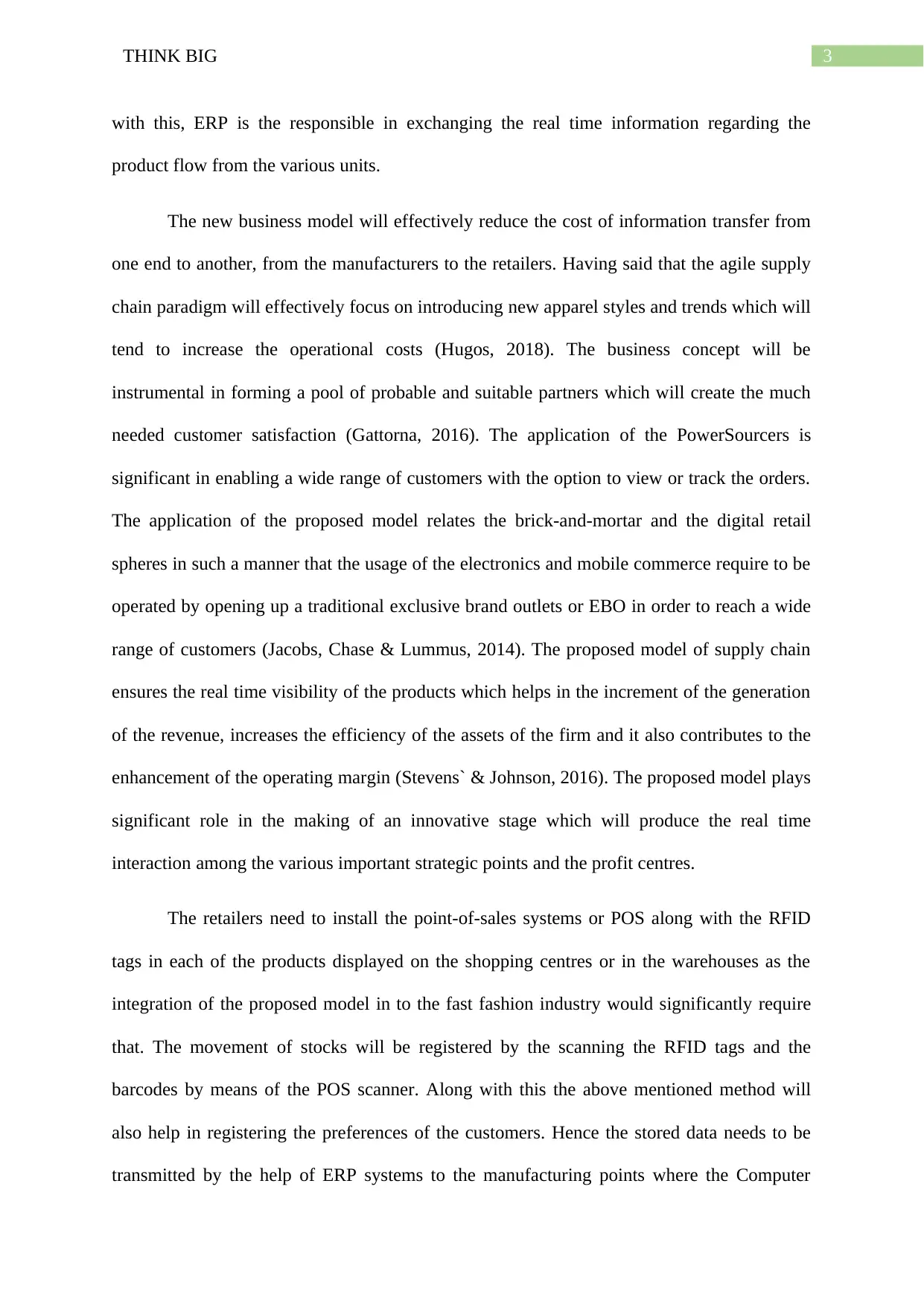
3THINK BIG
with this, ERP is the responsible in exchanging the real time information regarding the
product flow from the various units.
The new business model will effectively reduce the cost of information transfer from
one end to another, from the manufacturers to the retailers. Having said that the agile supply
chain paradigm will effectively focus on introducing new apparel styles and trends which will
tend to increase the operational costs (Hugos, 2018). The business concept will be
instrumental in forming a pool of probable and suitable partners which will create the much
needed customer satisfaction (Gattorna, 2016). The application of the PowerSourcers is
significant in enabling a wide range of customers with the option to view or track the orders.
The application of the proposed model relates the brick-and-mortar and the digital retail
spheres in such a manner that the usage of the electronics and mobile commerce require to be
operated by opening up a traditional exclusive brand outlets or EBO in order to reach a wide
range of customers (Jacobs, Chase & Lummus, 2014). The proposed model of supply chain
ensures the real time visibility of the products which helps in the increment of the generation
of the revenue, increases the efficiency of the assets of the firm and it also contributes to the
enhancement of the operating margin (Stevens` & Johnson, 2016). The proposed model plays
significant role in the making of an innovative stage which will produce the real time
interaction among the various important strategic points and the profit centres.
The retailers need to install the point-of-sales systems or POS along with the RFID
tags in each of the products displayed on the shopping centres or in the warehouses as the
integration of the proposed model in to the fast fashion industry would significantly require
that. The movement of stocks will be registered by the scanning the RFID tags and the
barcodes by means of the POS scanner. Along with this the above mentioned method will
also help in registering the preferences of the customers. Hence the stored data needs to be
transmitted by the help of ERP systems to the manufacturing points where the Computer
with this, ERP is the responsible in exchanging the real time information regarding the
product flow from the various units.
The new business model will effectively reduce the cost of information transfer from
one end to another, from the manufacturers to the retailers. Having said that the agile supply
chain paradigm will effectively focus on introducing new apparel styles and trends which will
tend to increase the operational costs (Hugos, 2018). The business concept will be
instrumental in forming a pool of probable and suitable partners which will create the much
needed customer satisfaction (Gattorna, 2016). The application of the PowerSourcers is
significant in enabling a wide range of customers with the option to view or track the orders.
The application of the proposed model relates the brick-and-mortar and the digital retail
spheres in such a manner that the usage of the electronics and mobile commerce require to be
operated by opening up a traditional exclusive brand outlets or EBO in order to reach a wide
range of customers (Jacobs, Chase & Lummus, 2014). The proposed model of supply chain
ensures the real time visibility of the products which helps in the increment of the generation
of the revenue, increases the efficiency of the assets of the firm and it also contributes to the
enhancement of the operating margin (Stevens` & Johnson, 2016). The proposed model plays
significant role in the making of an innovative stage which will produce the real time
interaction among the various important strategic points and the profit centres.
The retailers need to install the point-of-sales systems or POS along with the RFID
tags in each of the products displayed on the shopping centres or in the warehouses as the
integration of the proposed model in to the fast fashion industry would significantly require
that. The movement of stocks will be registered by the scanning the RFID tags and the
barcodes by means of the POS scanner. Along with this the above mentioned method will
also help in registering the preferences of the customers. Hence the stored data needs to be
transmitted by the help of ERP systems to the manufacturing points where the Computer
Paraphrase This Document
Need a fresh take? Get an instant paraphrase of this document with our AI Paraphraser
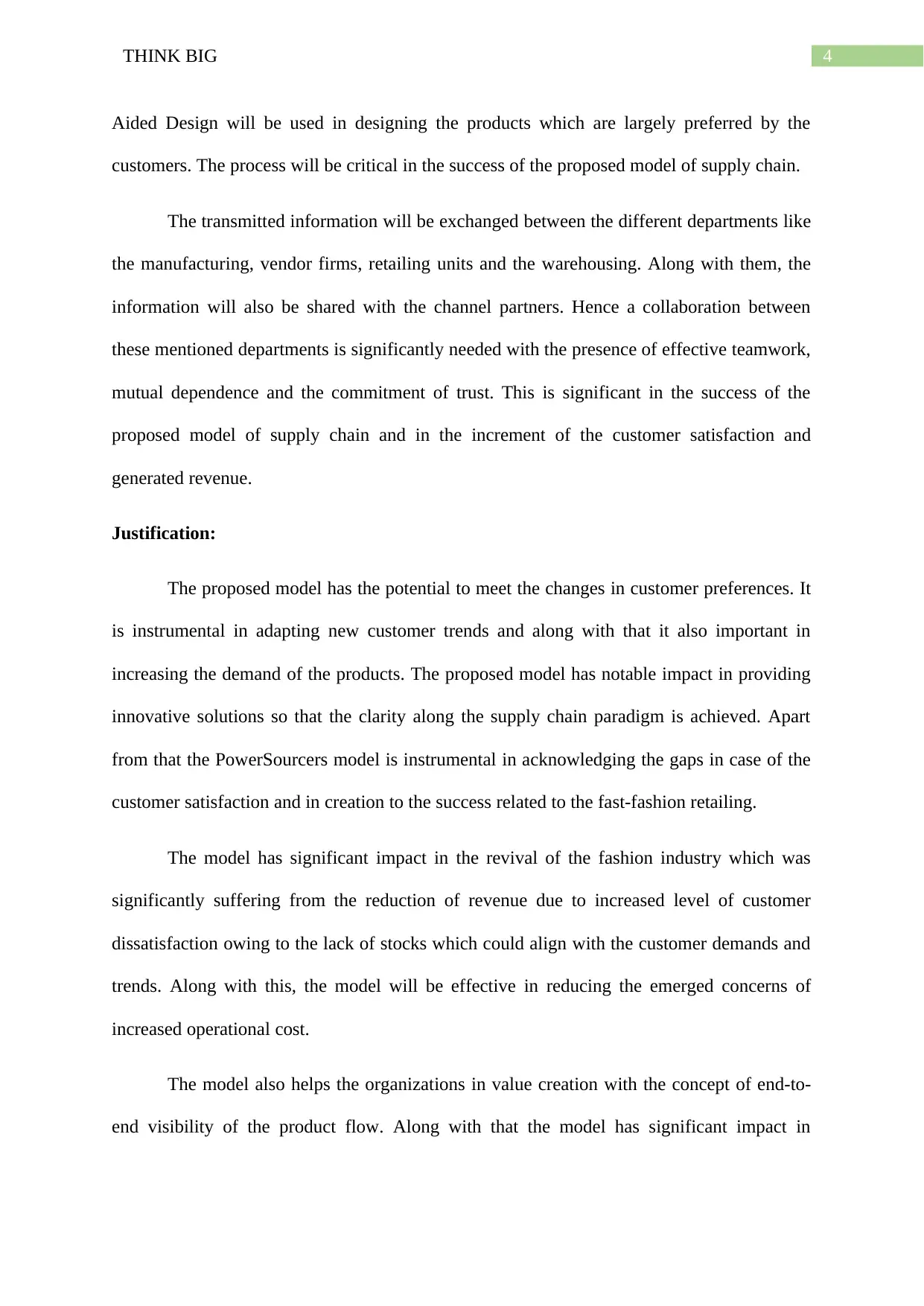
4THINK BIG
Aided Design will be used in designing the products which are largely preferred by the
customers. The process will be critical in the success of the proposed model of supply chain.
The transmitted information will be exchanged between the different departments like
the manufacturing, vendor firms, retailing units and the warehousing. Along with them, the
information will also be shared with the channel partners. Hence a collaboration between
these mentioned departments is significantly needed with the presence of effective teamwork,
mutual dependence and the commitment of trust. This is significant in the success of the
proposed model of supply chain and in the increment of the customer satisfaction and
generated revenue.
Justification:
The proposed model has the potential to meet the changes in customer preferences. It
is instrumental in adapting new customer trends and along with that it also important in
increasing the demand of the products. The proposed model has notable impact in providing
innovative solutions so that the clarity along the supply chain paradigm is achieved. Apart
from that the PowerSourcers model is instrumental in acknowledging the gaps in case of the
customer satisfaction and in creation to the success related to the fast-fashion retailing.
The model has significant impact in the revival of the fashion industry which was
significantly suffering from the reduction of revenue due to increased level of customer
dissatisfaction owing to the lack of stocks which could align with the customer demands and
trends. Along with this, the model will be effective in reducing the emerged concerns of
increased operational cost.
The model also helps the organizations in value creation with the concept of end-to-
end visibility of the product flow. Along with that the model has significant impact in
Aided Design will be used in designing the products which are largely preferred by the
customers. The process will be critical in the success of the proposed model of supply chain.
The transmitted information will be exchanged between the different departments like
the manufacturing, vendor firms, retailing units and the warehousing. Along with them, the
information will also be shared with the channel partners. Hence a collaboration between
these mentioned departments is significantly needed with the presence of effective teamwork,
mutual dependence and the commitment of trust. This is significant in the success of the
proposed model of supply chain and in the increment of the customer satisfaction and
generated revenue.
Justification:
The proposed model has the potential to meet the changes in customer preferences. It
is instrumental in adapting new customer trends and along with that it also important in
increasing the demand of the products. The proposed model has notable impact in providing
innovative solutions so that the clarity along the supply chain paradigm is achieved. Apart
from that the PowerSourcers model is instrumental in acknowledging the gaps in case of the
customer satisfaction and in creation to the success related to the fast-fashion retailing.
The model has significant impact in the revival of the fashion industry which was
significantly suffering from the reduction of revenue due to increased level of customer
dissatisfaction owing to the lack of stocks which could align with the customer demands and
trends. Along with this, the model will be effective in reducing the emerged concerns of
increased operational cost.
The model also helps the organizations in value creation with the concept of end-to-
end visibility of the product flow. Along with that the model has significant impact in
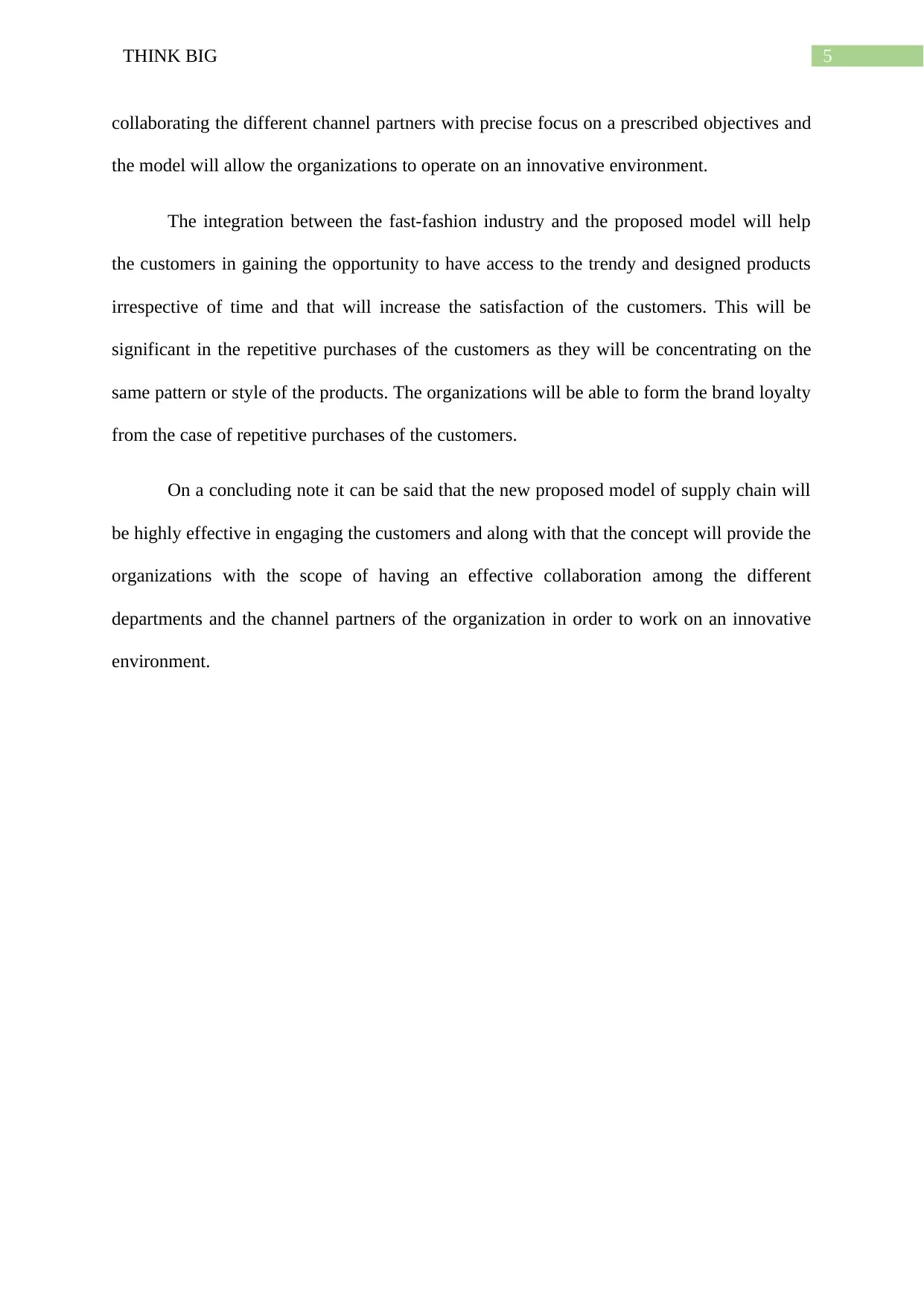
5THINK BIG
collaborating the different channel partners with precise focus on a prescribed objectives and
the model will allow the organizations to operate on an innovative environment.
The integration between the fast-fashion industry and the proposed model will help
the customers in gaining the opportunity to have access to the trendy and designed products
irrespective of time and that will increase the satisfaction of the customers. This will be
significant in the repetitive purchases of the customers as they will be concentrating on the
same pattern or style of the products. The organizations will be able to form the brand loyalty
from the case of repetitive purchases of the customers.
On a concluding note it can be said that the new proposed model of supply chain will
be highly effective in engaging the customers and along with that the concept will provide the
organizations with the scope of having an effective collaboration among the different
departments and the channel partners of the organization in order to work on an innovative
environment.
collaborating the different channel partners with precise focus on a prescribed objectives and
the model will allow the organizations to operate on an innovative environment.
The integration between the fast-fashion industry and the proposed model will help
the customers in gaining the opportunity to have access to the trendy and designed products
irrespective of time and that will increase the satisfaction of the customers. This will be
significant in the repetitive purchases of the customers as they will be concentrating on the
same pattern or style of the products. The organizations will be able to form the brand loyalty
from the case of repetitive purchases of the customers.
On a concluding note it can be said that the new proposed model of supply chain will
be highly effective in engaging the customers and along with that the concept will provide the
organizations with the scope of having an effective collaboration among the different
departments and the channel partners of the organization in order to work on an innovative
environment.
⊘ This is a preview!⊘
Do you want full access?
Subscribe today to unlock all pages.

Trusted by 1+ million students worldwide
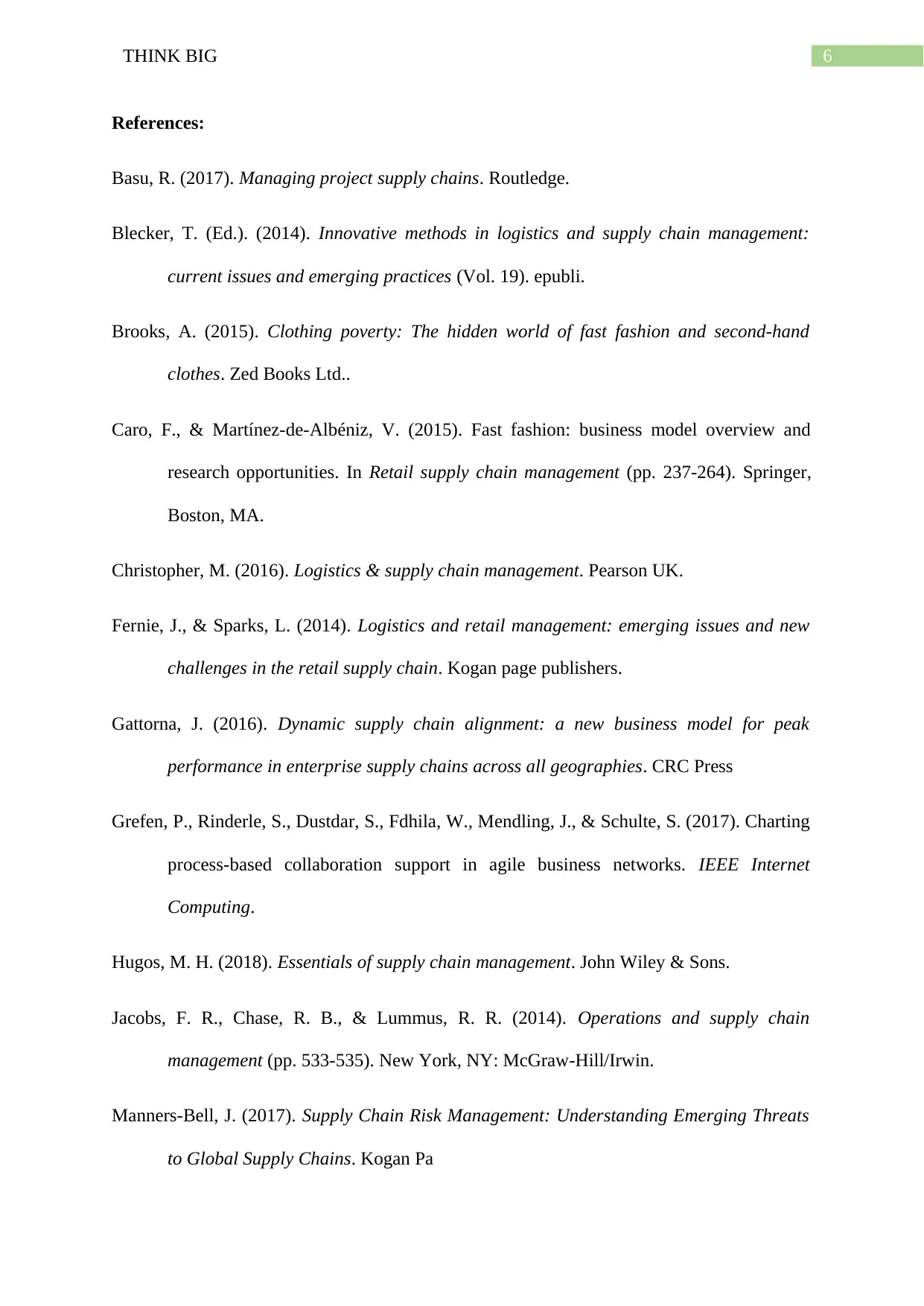
6THINK BIG
References:
Basu, R. (2017). Managing project supply chains. Routledge.
Blecker, T. (Ed.). (2014). Innovative methods in logistics and supply chain management:
current issues and emerging practices (Vol. 19). epubli.
Brooks, A. (2015). Clothing poverty: The hidden world of fast fashion and second-hand
clothes. Zed Books Ltd..
Caro, F., & Martínez-de-Albéniz, V. (2015). Fast fashion: business model overview and
research opportunities. In Retail supply chain management (pp. 237-264). Springer,
Boston, MA.
Christopher, M. (2016). Logistics & supply chain management. Pearson UK.
Fernie, J., & Sparks, L. (2014). Logistics and retail management: emerging issues and new
challenges in the retail supply chain. Kogan page publishers.
Gattorna, J. (2016). Dynamic supply chain alignment: a new business model for peak
performance in enterprise supply chains across all geographies. CRC Press
Grefen, P., Rinderle, S., Dustdar, S., Fdhila, W., Mendling, J., & Schulte, S. (2017). Charting
process-based collaboration support in agile business networks. IEEE Internet
Computing.
Hugos, M. H. (2018). Essentials of supply chain management. John Wiley & Sons.
Jacobs, F. R., Chase, R. B., & Lummus, R. R. (2014). Operations and supply chain
management (pp. 533-535). New York, NY: McGraw-Hill/Irwin.
Manners-Bell, J. (2017). Supply Chain Risk Management: Understanding Emerging Threats
to Global Supply Chains. Kogan Pa
References:
Basu, R. (2017). Managing project supply chains. Routledge.
Blecker, T. (Ed.). (2014). Innovative methods in logistics and supply chain management:
current issues and emerging practices (Vol. 19). epubli.
Brooks, A. (2015). Clothing poverty: The hidden world of fast fashion and second-hand
clothes. Zed Books Ltd..
Caro, F., & Martínez-de-Albéniz, V. (2015). Fast fashion: business model overview and
research opportunities. In Retail supply chain management (pp. 237-264). Springer,
Boston, MA.
Christopher, M. (2016). Logistics & supply chain management. Pearson UK.
Fernie, J., & Sparks, L. (2014). Logistics and retail management: emerging issues and new
challenges in the retail supply chain. Kogan page publishers.
Gattorna, J. (2016). Dynamic supply chain alignment: a new business model for peak
performance in enterprise supply chains across all geographies. CRC Press
Grefen, P., Rinderle, S., Dustdar, S., Fdhila, W., Mendling, J., & Schulte, S. (2017). Charting
process-based collaboration support in agile business networks. IEEE Internet
Computing.
Hugos, M. H. (2018). Essentials of supply chain management. John Wiley & Sons.
Jacobs, F. R., Chase, R. B., & Lummus, R. R. (2014). Operations and supply chain
management (pp. 533-535). New York, NY: McGraw-Hill/Irwin.
Manners-Bell, J. (2017). Supply Chain Risk Management: Understanding Emerging Threats
to Global Supply Chains. Kogan Pa
Paraphrase This Document
Need a fresh take? Get an instant paraphrase of this document with our AI Paraphraser

7THINK BIG
Remy, N., Speelman, E., & Swartz, S. (2016). Style that’s sustainable: a new fast-fashion
formula. McKinsey & Company, 1-6.
Stevens, G. C., & Johnson, M. (2016). Integrating the supply chain… 25 years on.
International Journal of Physical Distribution & Logistics Management, 46(1), 19-42.
Remy, N., Speelman, E., & Swartz, S. (2016). Style that’s sustainable: a new fast-fashion
formula. McKinsey & Company, 1-6.
Stevens, G. C., & Johnson, M. (2016). Integrating the supply chain… 25 years on.
International Journal of Physical Distribution & Logistics Management, 46(1), 19-42.
1 out of 8
Related Documents
Your All-in-One AI-Powered Toolkit for Academic Success.
+13062052269
info@desklib.com
Available 24*7 on WhatsApp / Email
![[object Object]](/_next/static/media/star-bottom.7253800d.svg)
Unlock your academic potential
Copyright © 2020–2025 A2Z Services. All Rights Reserved. Developed and managed by ZUCOL.





